NEW YORK–The 2022 edition of Asia Week New York returns with its trademark whirlwind schedule of captivating gallery exhibitions, auction sales and museum shows, which runs from March 16th through March 25th. Spread out across the city, 22 international galleries will open their doors to the public, with 4 others exhibiting online, while Bonhams, Christie’s, Doyle, Heritage Auctions, iGavel, and Sotheby’s will hold 14 in-person auctions with 6 online sales starting March 21st through March 25th.
“Asia Week New York is extremely delighted to welcome back collectors, curators and Asian art enthusiasts with an exciting calendar of in-person activities at the galleries and auction houses,” said chairman Dessa Goddard. “Our participants look forward to presenting an abundance of alluring Asian art treasures that they’ll unveil to the public for the first time.”
For the past 13 years, Asia Week New York has attracted discerning collectors and connoisseurs drawn to the fascinating exhibitions—always free and open to the public—featuring the rarest and finest examples of Asian porcelain, jewelry, textiles, paintings, ceramics, sculpture, bronzes, prints, photographs, and jades from different Asian countries from 2000 BC to the present. Organized by category, here are some of the not-to-be-missed highlights to be discovered at the participating galleries in March:
Ancient and/or Contemporary Indian, Himalayan and Southeast Asian Art
New Delhi-based, Akar Prakar presents Jayashree Chakravarty: Feeling the Pulse (in the pandemic year). With disruptions and disasters that have caused us to experience sudden, inexplicable loss, extreme vulnerability, and anxiety all around us, Chakravarty seeks recuperative energies as interpreted in Connecting using acrylic, oil paper, shell flakes, synthetic adhesive and cotton on canvas. Online only
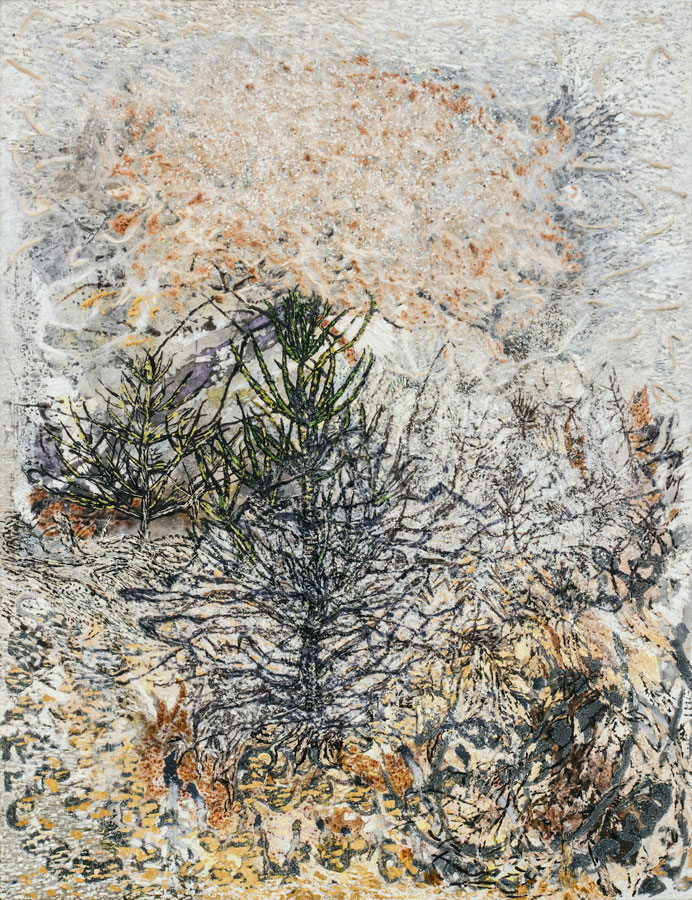
Among the Delightful Images: Indian Paintings and Courtly Objects at Art Passages is Nawab of Oudh Shuja ud-Daula seated in a pavilion writing a letter, painted by the court artist Gobind Singh, circa 1760. Shuja ud-Daula was an important and powerful ruler of Oudh (Awadh) between 1754-75 and Chief Minister to the Mughal Emperor Shah ‘Alam between 1759-1806, at the time of the breakdown of the Mughal Empire. Singh was an important artist whose training was at the royal atelier of the Mughal Emperor Muhammad Shah. He was quite active at the courts in Lucknow and Faizabad and later contributed to several paintings in albums created for foreign officials and patrons of Indian art. 1018 Madison Avenue, Suite 5
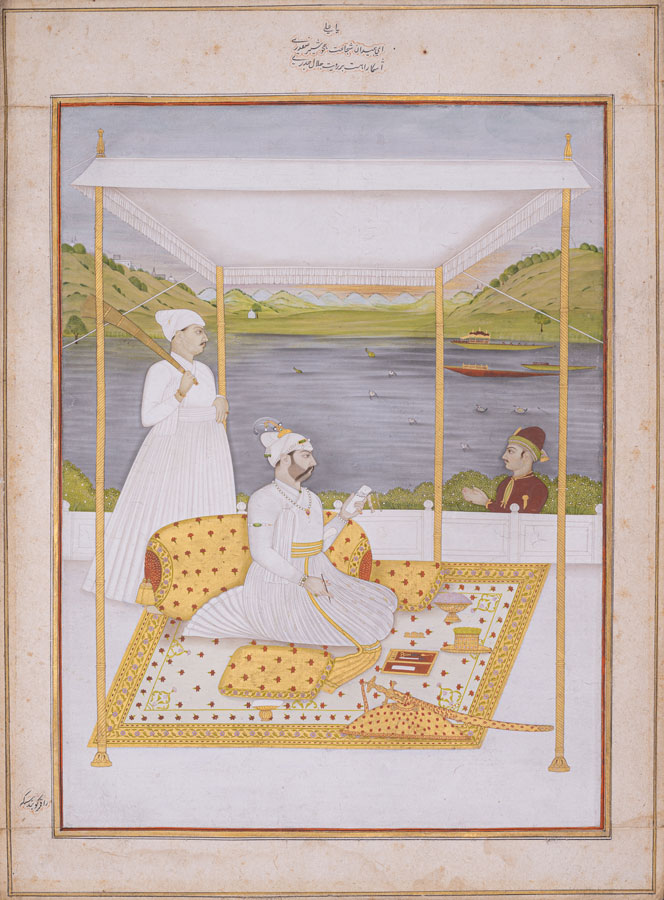
In Women Artists from 20th Century India, at DAG, an acrylic on wood sculpture titled Surveyor and the Surveyed, by Navjot, takes center stage. This sculpture, with its reference to African wood sculpture was a result of Navjot’s excursions into the forested heartlands of India. She examines the representation of the female body from the point of view of women who have been instructed, since childhood, to survey their bodies as a response to being constantly surveyed by others. The Fuller Building, 41 East 57th Street, Suite 708
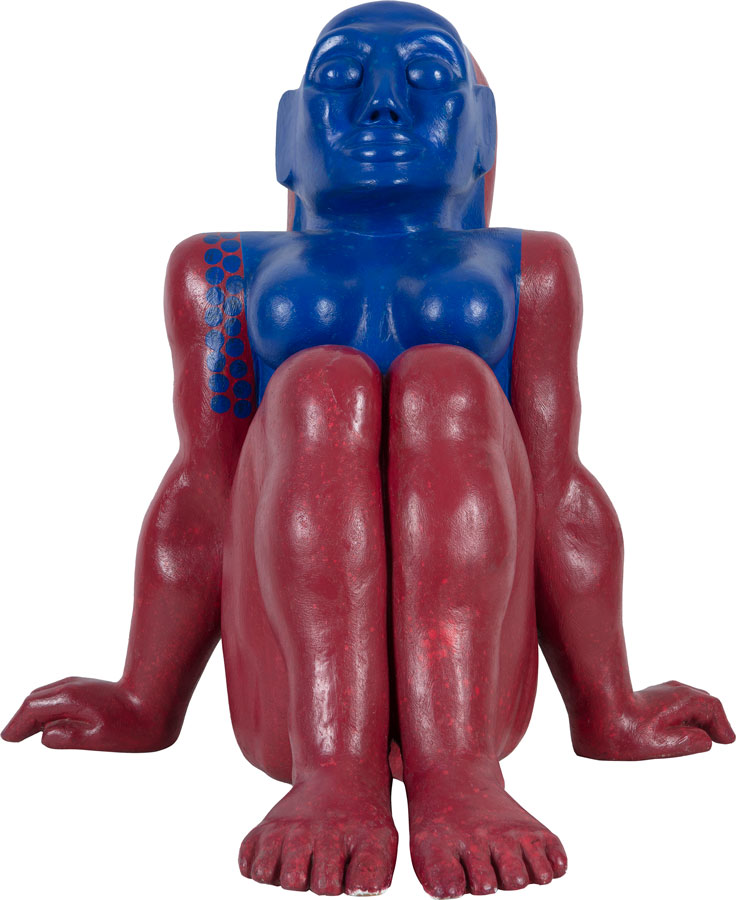
Indian Court Paintings at the London-based, Oliver Forge & Brendan Lynch Ltd., includes a striking image of the Hindu God Vishnu as Venkateshvara, dated to the late 18th century. This gouache heightened with gold on paper, depicts the four-armed Hindu god Vishnu in his human avatar as Venkateshvara or forgiver of sins. It was painted in Andhra Pradesh in south India, probably at Tirupati, north-west of Madras (Chennai), where a school of painting flourished in the eighteenth century. The style of painting, with lavish use of gold, is distinctly south Indian.
67 East 80th Street, Suite 2
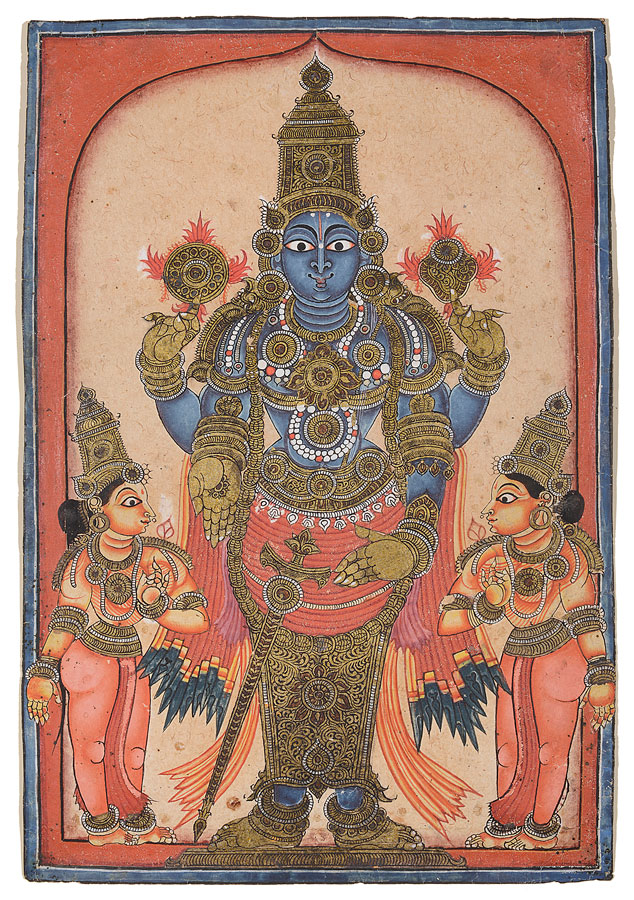
In her exhibition, Court, Epic, Spirit: Indian Art 15th-19th Century, Francesca Galloway–also here from London–will feature a rare and important folio from the Dastan-i Amir Hamza (Hamzanama or ‘Story of Hamza’) commissioned by the Emperor Akbar, circa 1565. The Hamzanama, its usual abbreviated title, is a rambling series of tales dealing with the mythical adventures of Amir Hamza, the uncle of the Prophet. Here, Hamza clings to the Rukh’s legs to carry him home across the sea. 17 White Street
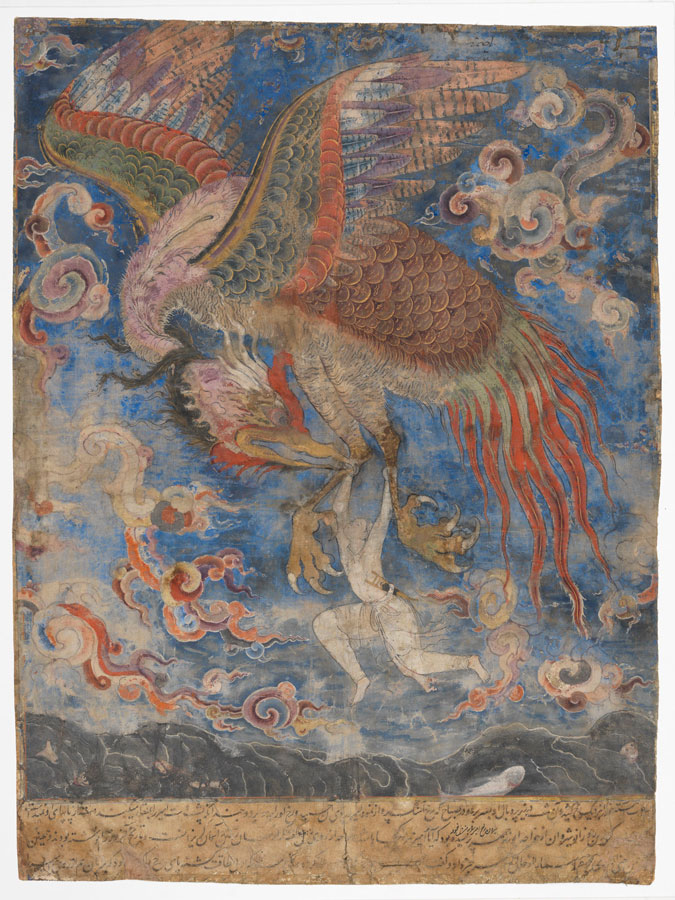
Kapoor Galleries’ exhibition titled Dhanvantari’s Blessing will feature a 4th century Buddha Head, from the ancient region of Gandhara, now in modern-day Pakistan. This sculpture is made of schist, a widely used material in the Gandharan period, which allowed for detailed carving, as exemplified by the deep definition of the hair which undulates in symmetrical waves from the Buddha’s center part, framing his face with a widow's peak.
34 East 67th Street

A magnificent Attush robe, is just one of the pieces in Important Indian & Indonesian Textiles at Thomas Murray, and was made by the Ainu people, in Hokkaido, the northern most island of Japan. The tan-colored ground cloth is from elm-bark fiber and decorated with appliquéd indigo cotton, silk tassels, shells, marine creatures, and white embroidery. With compelling ancient graphic designs known to ward off evil, this robe is one of the finest ever to come to light and likely belonged to a shaman or a high-status chief.
Online or by appointment (415-378-0716)
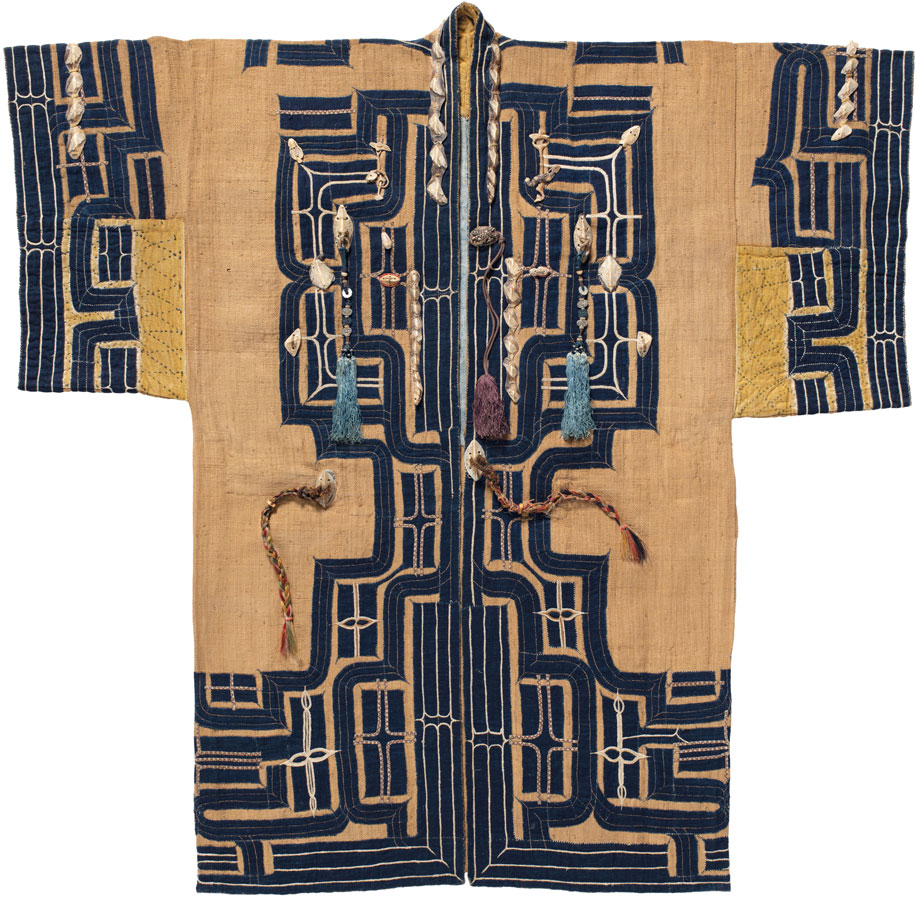
Ancient and/or Contemporary Chinese Art
On view at Ralph M. Chait Galleries, Spring Exhibition of Chinese Porcelain and Works of Art is a rare set of three Qingbai Glazed String Design Ewers, from the Northern Song period, 10th century. This form–with its string design of a delightful and whimsical variation on a classic form–is very rare. 16 East 52nd Street, Suite 1002.
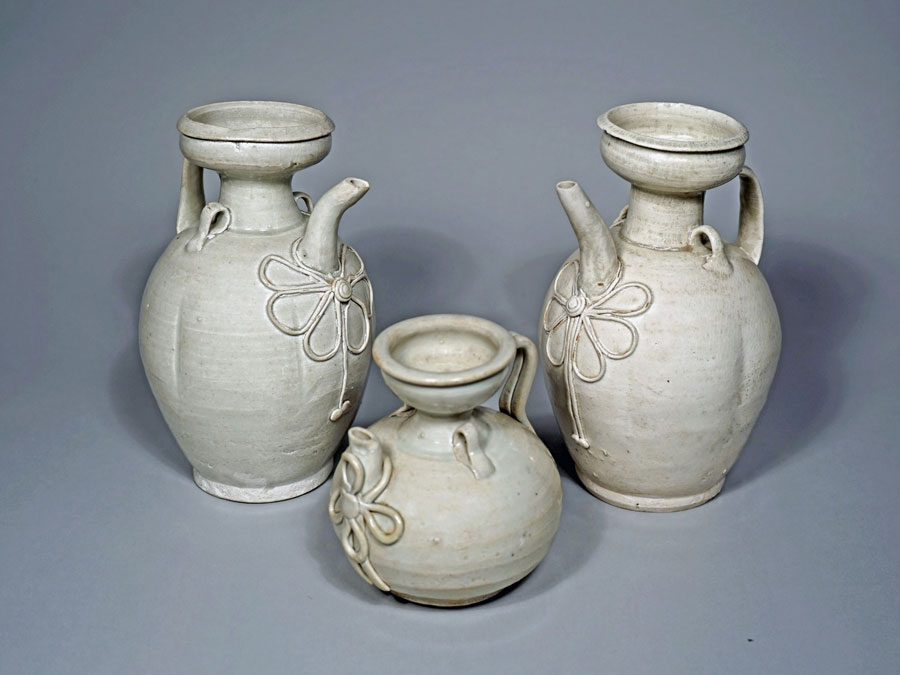
Newcomer Fu Qiumeng Fine Art presents Ink Affinities: The Collaborative Works of Arnold Chang and Michael Cherney. The most innovative and experimental of all the works in the exhibition is Saltscape Lattice. The "salt print" was one of the earliest processes for producing positive photographic images on a sheet of standard drawing paper; wetting a paper sheet with a salt solution was the first step in making it sensitive to light. As an homage to this process, Cherney photographed salt crystals dissolving under a microscope When printed, the fractal qualities of the images are enhanced and take on the appearance of rocks, flowers, or other natural forms. By arranging them into the shape of a lattice for printing, Cherney created a “canvas” of random, yet orderly configurations that Morristown, New Jersey based Chang could attempt to weave into a coherent composition.
65 East 80th Street, Ground Floor
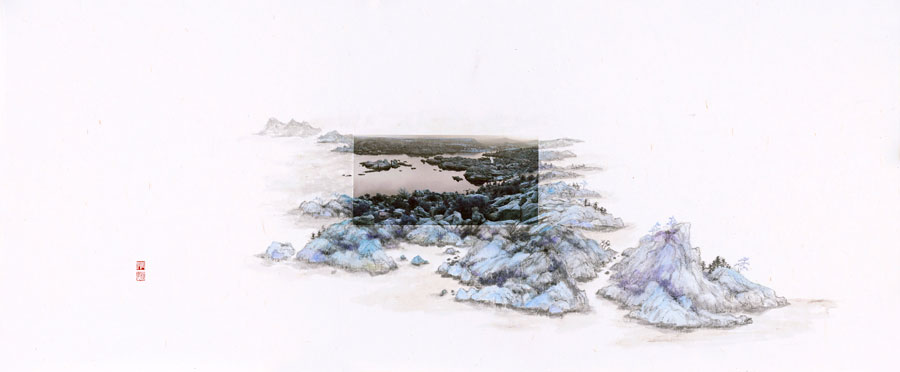
The highlight at INKstudio is Traveling through Sacred Mountains, by Bingyi, which is part of the exhibition called Bingyi: Land of the Immortals. A calligrapher, painter, film maker, poet and land artist, Bingyi reimagines the history of Chinese landscape painting from the Northern and Southern Song masters such as Guo Xi and Li Tang. Primarily concerned with the themes of ecology, ruins, rebirth, and poetic imagination, Bingyi’s work is also part of “Making Waves,” in collaboration with Joan B Mirviss LTD. 39 East 78th Street, Suite 401
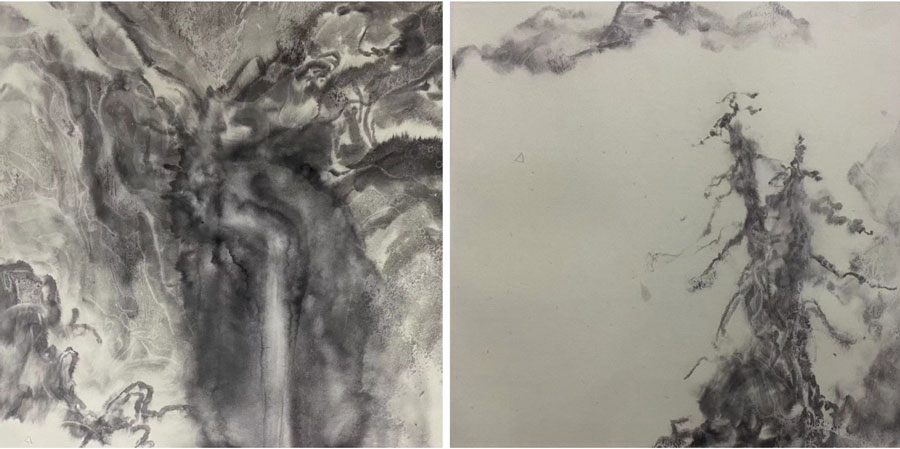
In the exhibition, The Ancients Among Us; Chinese and Japanese paintings and works of art, Kaikodo LLC, features a bronze Taotie mask with a ring handle from the 4-5th century. The taotie is an exceptional motif related to Chinese culture, prevalent during the Bronze Age. It appears as a decorative embellishment in the arts and crafts of China over several millennia, down to the present day. During the Han and Six Dynasties period the frontal, bilaterally symmetrical zoomorphic masks produced in bronze and fitted with loose ring handles were a common accoutrement. Online only

One of the many exquisite highlights in Chinese Ceramics from Tang-Yuan Dynasty, the exhibition at Zetterquist Galleries, is a Xing-yao bottle vase from the Tang Dynasty. A porcelaneous stoneware bottle vase with baluster shaped body and a flat foot, this piece is beautifully proportioned, with a tapered neck rising from a cushioned indentation, which flares to a beveled mouth-rim. 3 East 66th Street, Suite 2B
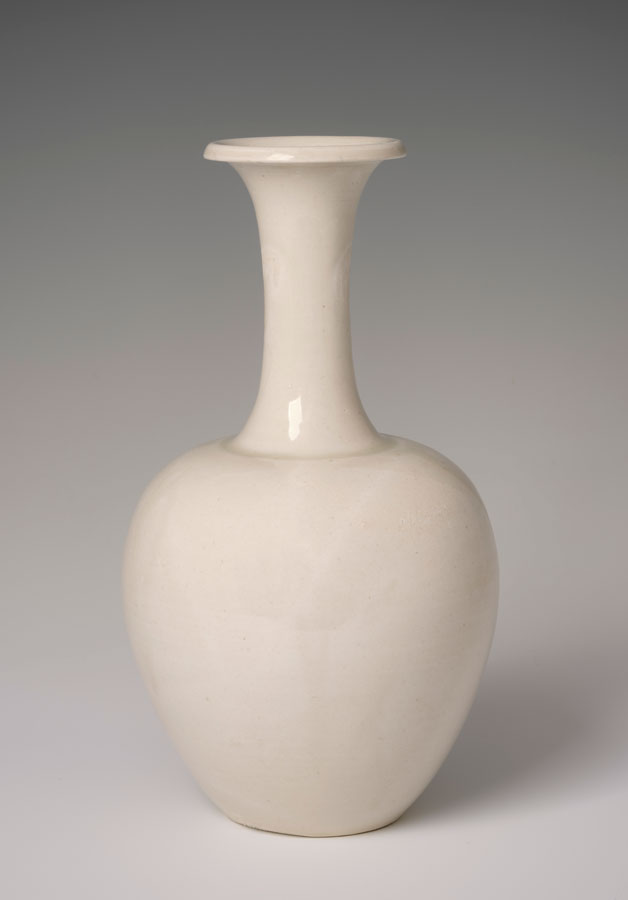
Ancient and/or Contemporary Japanese Art
In Two Hundred Years of Japanese Prints: Fine Japanese prints from inventory with works ranging from classical ukiyo-e to early sosaku hanga The Art of Japan is featuring a color woodblock print called Black Cat and Tomato Plant, by Takahashi Hiroaki, dated 1931, in an edition of 100. This charming print is twice the usual size and printed on thick hosho showing a black and white cat on the hunt and winding his way around a tomato plant. The Mark Hotel, 25 East 77th Street, Suite 215 (March 18-21)
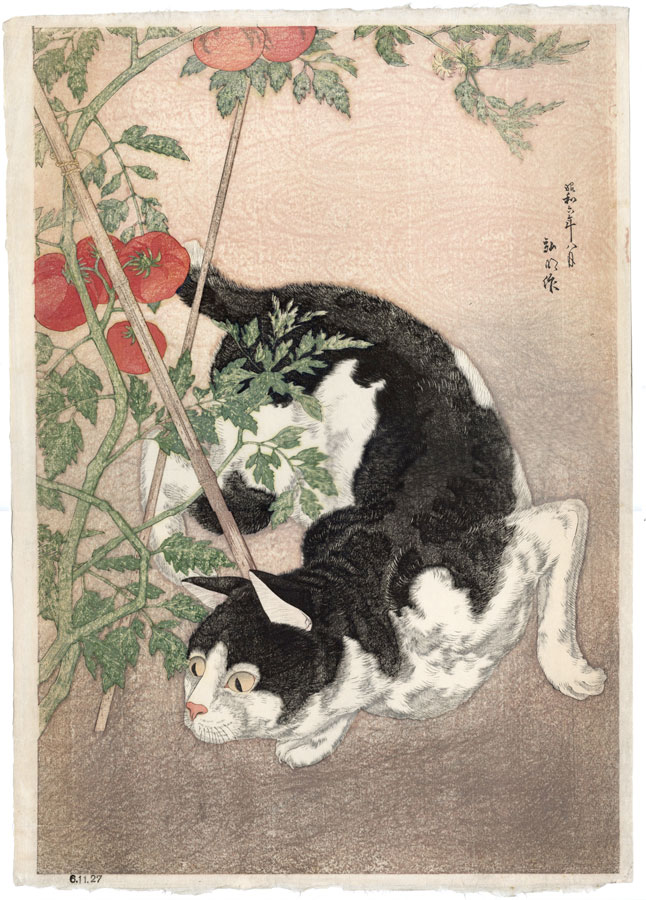
Jomon Spiral, by Ayumi Shigematsu, is one of the many stoneware pieces offered at Dai Ichi Arts, Ltd. in their exhibition, Future Forms: Avant-Garde Sculpture in Modern Japanese Ceramics. Ayumi is part of a vanguard generation of highly influential post-war female artists in Japan whose practices are inspired by concepts of female sexuality and representations of nature. With this piece the artist reflects on the hand-building clay production founded during the Jomon Era. Jomon, or cord-patterned pottery, is a method of hand-building clay used by women during this period before wheel-thrown pottery traditions were established in Japan. 18 East 64th Street, 1F

Egenolf Gallery Japanese Prints presents Mount Yoshino Midnight-Moon from “One Hundred Aspects of the Moon,” by Tsukioka Yoshitoshi, a color woodblock print, dated 1886. The juxtaposition of beauty and violence is captured as this beautiful court lady, Iga no Tsubone, fearlessly confronts the ghost of Kiyotaka. Her long hair flows freely down her back as maple leaves float down beneath a shadowed full moon. The ghost is clutching at the title cartouche with his eerie fingers and glaring at her with yellow eyes. Online only

Ippodo Gallery is mounting Chaos to Cosmos, a single artist exhibition featuring the work of Ken Matsubara. One of the paintings, titled Chaos, is inspired by "Nikawa Hakudo Zu," which Matsubara saw when he was a child at the Zendoji Temple. This piece is particularly spectacular not only because of its size but also because of the material. Matsubara creates all his paints naturally from his local surroundings. He collects fine minerals and pigments and forms earthy tones of brilliance and creates the extraordinary texture by applying clay layers on a washi paper background. This composition illustrates a beautiful but not overbearing essence of chaos.
32 East 67th Street, 3rd Floor

In their exhibition Privately Commissioned Japanese Prints & Albums from the Late 18th and 19th Centuries–Sebastian Izzard LLC Asian Art will feature a complete set of color woodblock prints in the series Eight Views of the Suburbs of Edo, each signed by Utagawa Hiroshige, the great master of traditional woodblock printing. Here we see one of them, Autumn Noon on the Tama River.
17 East 76th Street, 3rd Floor
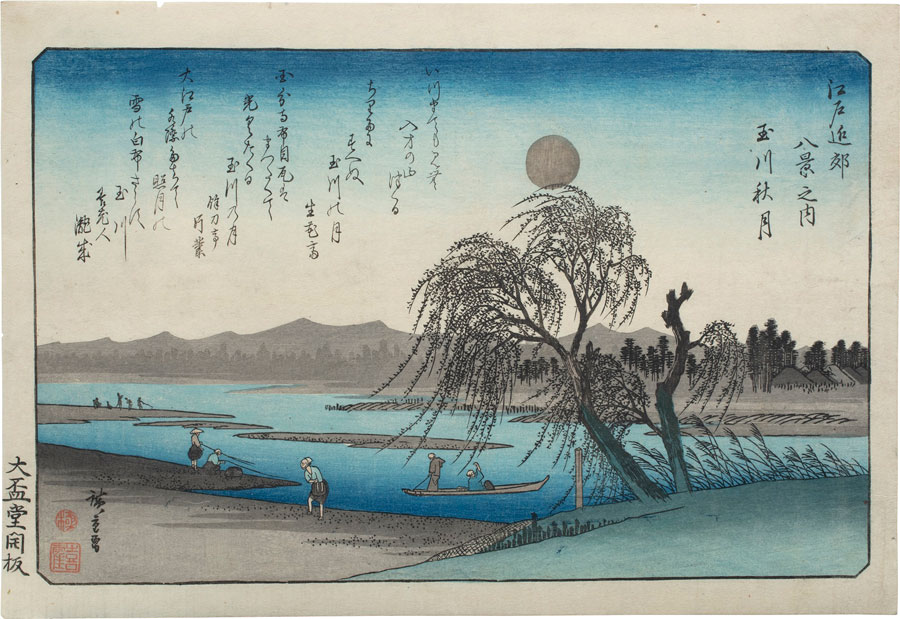
Nami, Wave is just one of the 30 spectacular works by the celebrated artist Kondo Takahiro on view at Joan B Mirviss Ltd. Kondo Takahiro: Making Waves includes his new sculptures in swirling black, gray, and white marbleized porcelain which marry his mastery of clay with his passion for painting. His signature silver mist overglaze creates the illusion of beading droplets over pooling "ink" running over the surfaces of his angular monoliths, vessels capped with cast glass, and sculptural tea bowls. In collaboration with INKstudio, the gallery will also show contemporary ink paintings by rising star Bingyi, who was inspired to create her latest works to accompany Kondo's sculptures.
39 East 78th Street, 4th Floor, Suite 401
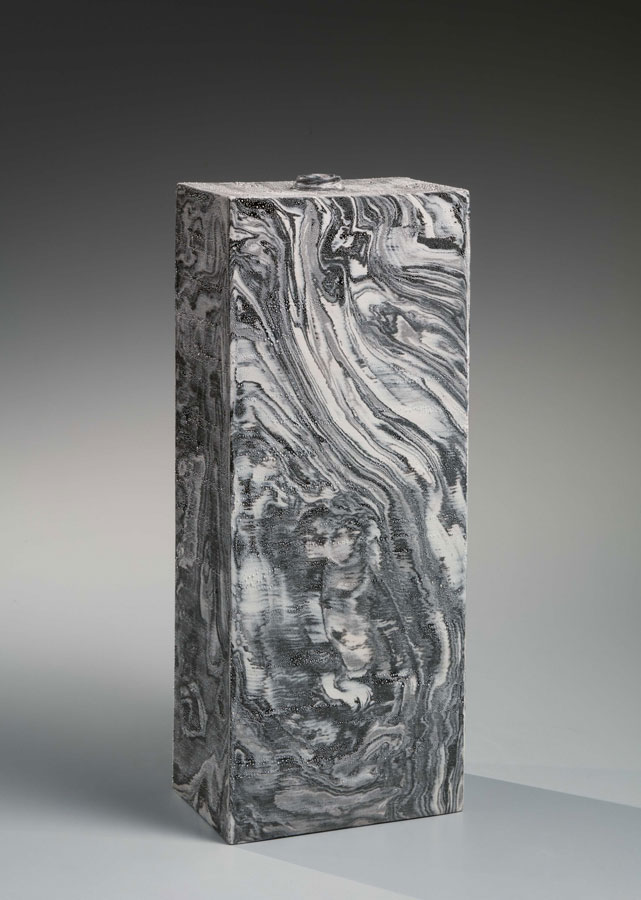
In the exhibition, The Eternal Beauty of Metal, at Onishi Gallery, is Sako Ryuhei’s modern interpretation of mokumegane, a centuries-old metalworking technique steeped in rich history and tradition. To create the intricate pattern, Sako forges twenty to thirty layers of metal under incredibly high temperatures. Once the metals have amalgamated into a single, thick billet, she then incises the billet, revealing the stratum of metals below. Afterwards, she flattens the incised billet into a thin, circular sheet, allowing the layered metal to form organic patterns. Finally, using a metalworking hammer, the sheet is hammered into the artist's desired shape. 521 West 26th Street
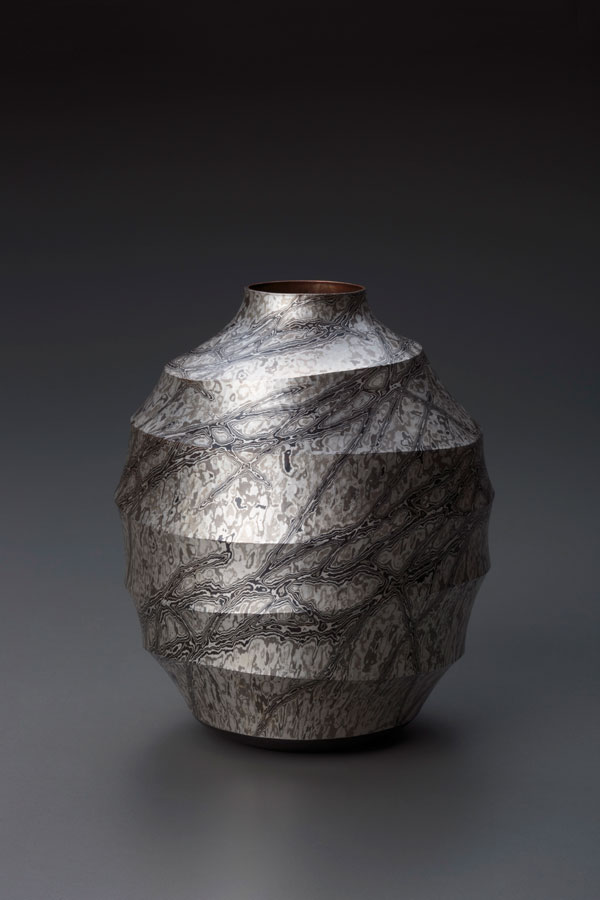
Milan-based Giuseppe Piva Japanese Art returns to New York in-person, with an imposing 19th century rust-iron articulated figure of a hawk. This Jizai Okimono is constructed of numerous hammered plates jointed inside the body; its head, wings, and claws move remarkably smoothly, as do the feathers which move individually and can spread. The fearsome beauty and predatory features of hawks–with their sharp beaks, keen eyes, long curving talons–made them metaphors of martial training and the warrior spirit. Samurai found in the brave and daring nature of these birds a congenial expression of their own ideals. To collect and maintain fine hawks constituted a status-symbol of the warrior class.
Adam Williams Fine Art, 24 East 80th Street
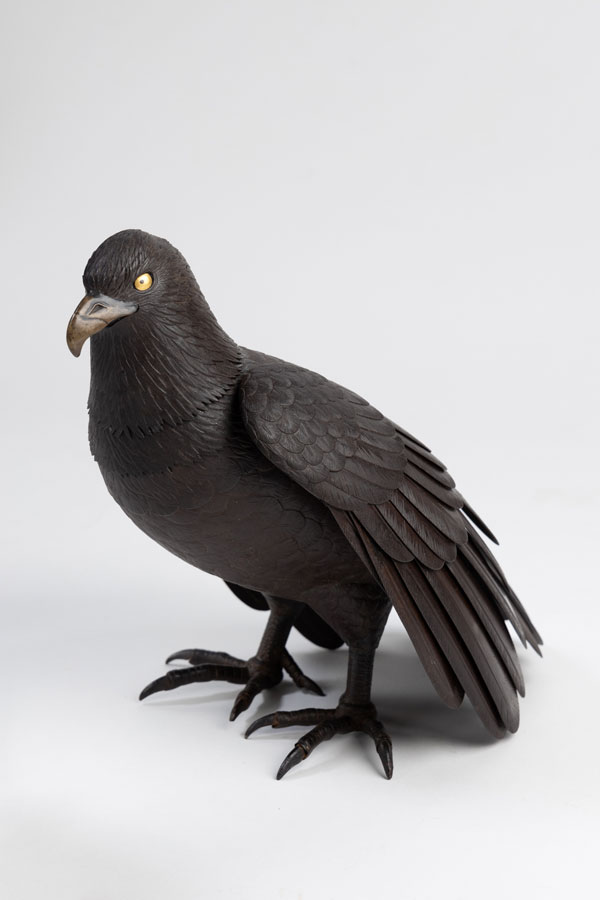
Scholten Japanese Art presents The Bridge, a snowy landscape print by B.J.O Nordfeldt. This excellent example of American Japonisme illustrates the theme of the upcoming exhibition, Influencers: Japonisme and Modern Japan, which will bring together works by Western artists who derived inspiration from Japanese art, and the response by Japanese artists in the development of a modern international style. 145 West 58th Street, Suite 6D
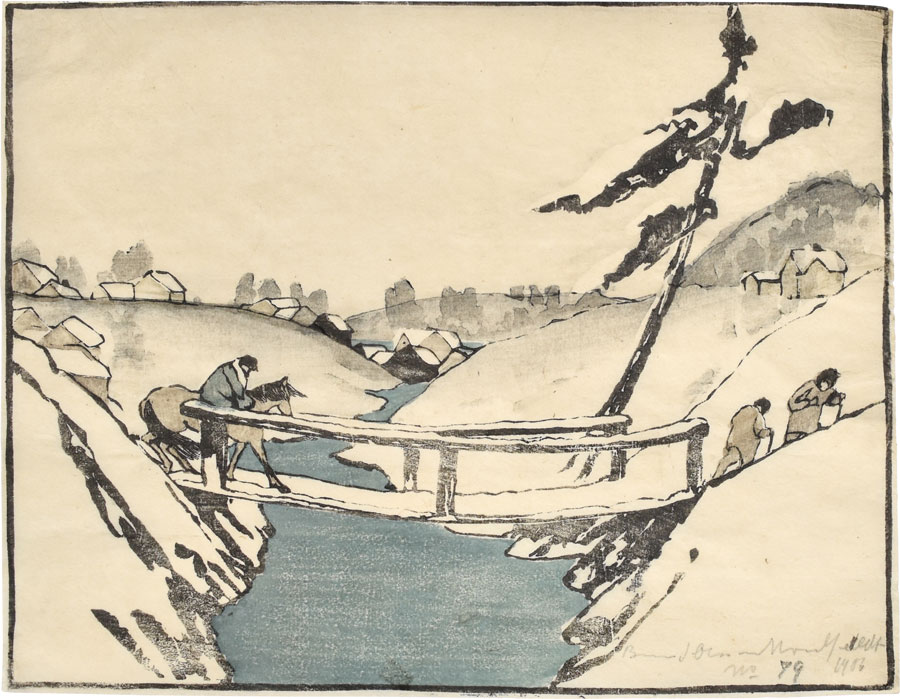
TAI Modern always offers us some interesting bamboo shapes and this piece does not disappoint. Meoto Iwa (The Wedded Rocks) is one of the pieces by Yufu Shohaku, featured in his solo exhibition at the gallery. The 80-year-old artist–known for his robust and energetic, rough-plaited baskets that incorporate bamboo branches and roots, half-split chunks of bamboo, and bamboo ropes–spent much of 2020 working on this sculptural homage to connection and new beginnings.
Colnaghi, 38 East 70th Street

Modern Masterpieces from the Taisho to Early Showa Eras at Thomsen Gallery includes a dramatic mountain landscape painted by Eiryō Satake onto this monumental pair of six-panel screens which spans 22 feet in width. Satake was famous for his landscapes and exhibited numerous times in the annual national art exhibitions during the modern pre-war era.
9 East 63rd St, Floor 2

From Hiroshi Yanagi Oriental Art comes a painted 18th century hagoita battledore–made from wood, lacquer, gold leaf, and Gofun, which is ground clamshell. At first, hagoita racquets were used to play the game of shuttlecock (Japanese badminton). The custom emerged where hagoita racquets were given to women at the start of the new year as a talisman to ward off evil and to bring good fortune. Nicholas Hall, 17 East 76th Street, 4F

Asia Week New York newcomer MIYAKO YOSHINAGA is mounting In the Space of the Near and Distant, a solo exhibition by Jonathan Yukiko Clark, a Hawaii-based Japanese-American artist. This show will consist of monotype prints and sculptures informed by the traditional Japanese living space, where the transience of nature and human life are closely connected as exemplified in the work, titled Imprint of Mihara. 24 East 64th Street, Third Floor

Ancient and/or Contemporary Korean Art
At HK Art & Antiques LLC, the sole Korean art participant, Heakyum Kim, is delighted to present Korean Paintings and Sculpture: Past and Present. One of the highlights is a bronze sculpture called Shadow of a Bird, by contemporary artist Wonsook Kim, whose story-based figurative paintings and sculptures are poetic and ethereal in their fluid execution and mythical subject matter.
49 East 78th Street, Suite 4B
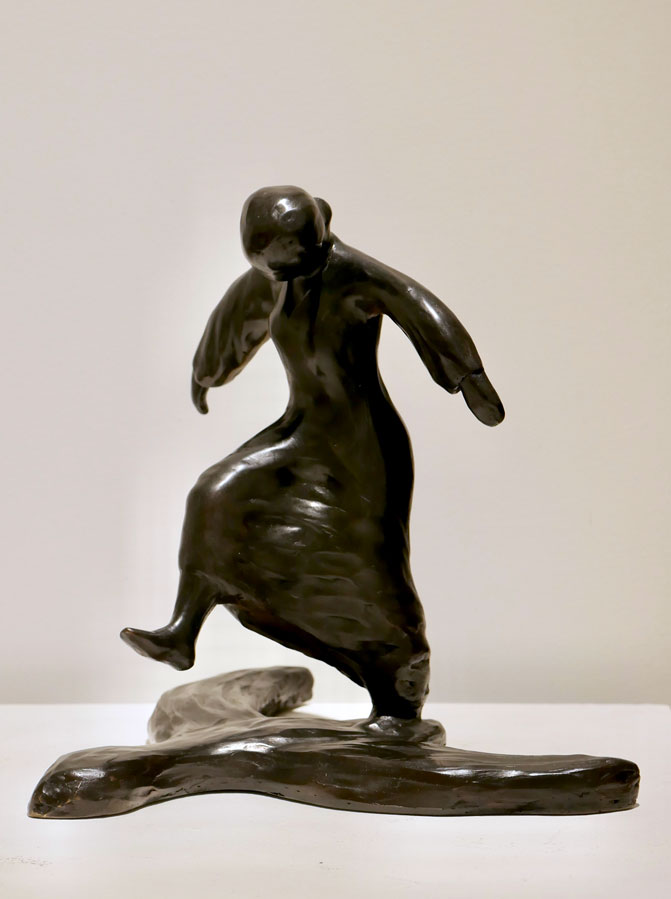
About Asia Week New York
The collaboration of top-tier international Asian art galleries, the six major auction houses, Bonhams, Christie’s, Doyle, Heritage Auctions, iGavel, and Sotheby’s, and numerous museums and Asian cultural institutions, Asia Week New York is a week-long celebration filled with a non-stop schedule of simultaneous gallery open houses, Asian art auctions as well as numerous museum exhibitions, lectures, and special events. Participants from Great Britain, India, Italy, Japan, and the United States unveil an extraordinary array of museum-quality treasures from China, India, the Himalayas, Southeast Asia, Tibet, Nepal, Japan, and Korea.
Asia Week New York Association, Inc. is a 501(c)(6) non-profit trade membership organization registered with the state of New York. For more information visit www.AsiaWeekNewYork.com @asiaweekny #asiaweekny
About Songtsam, Presenting Sponsor
Continuing as Presenting Sponsor for Asia Week New York is Songtsam Hotels, Resorts & Tours, an award-winning luxury boutique hotel group with thirteen properties (twelve hotels and one glamping site, located in the Chinese provinces of Tibet and Yunnan.
Founded by Baima Duoji, in 2000, the Songtsam Group is the only collection of luxury Tibetan-style retreats found across the Tibetan Plateau that offers guests sophisticated elegance, refined design, modern amenities, and unobtrusive service in places of natural beauty and cultural interest. With his long-standing and strong interest in Chinese, Himalayan, and Southeast Asian art, Mr. Baima started collecting art long before he established his first hotel, Songtsam Lodge Shangri-La, which is located next to the famous Songzanlin Monastery in Shangri-La. Many of the properties across the Tibetan plateau are decorated with Mr. Baima’s personal collection, with each hotel acting as a private art museum. For more information, visit www.songtsam.com.
Link to images and captions: www.asiaweekny.com/press-images
